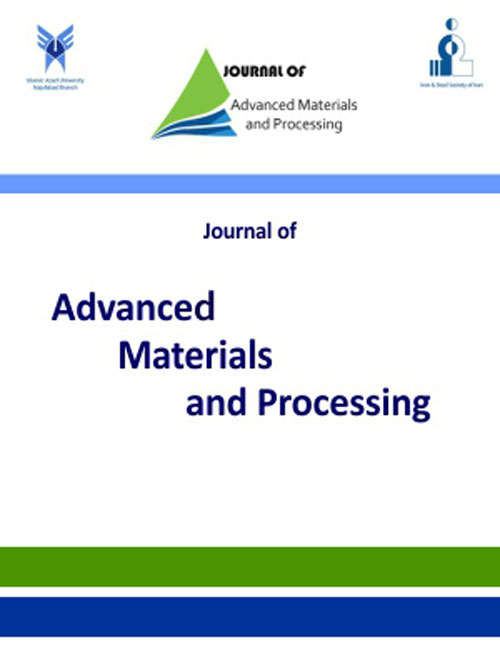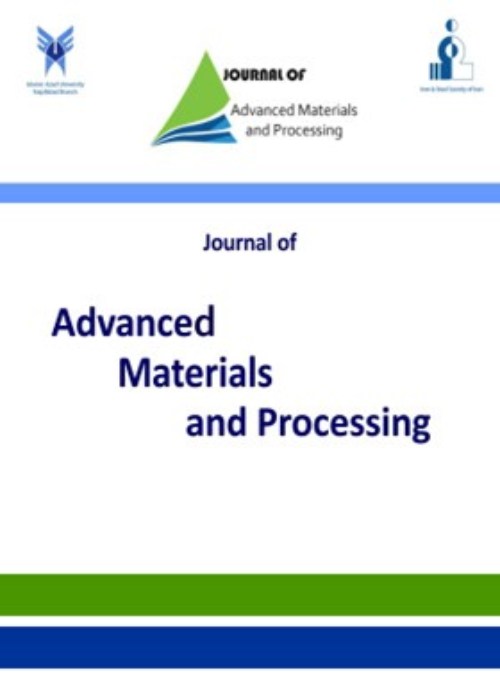فهرست مطالب

Journal of advanced materials and processing
Volume:3 Issue: 2, Spring 2015
- تاریخ انتشار: 1394/04/13
- تعداد عناوین: 8
-
-
Pages 3-10Copper nanoparticles were synthesized on multiwall carbon nanotubes, (Cu)/(MWCNTs), based on solvothermal method. The used reagents include MWCNTs, cupric nitrate trihydrate (Cu (NO3)2.3H2O), diethylene glycol (DEG), diethanol amine. Characterization of Cu/MWCNTS nanoparticles was performed by techniques of Fourier transform infrared spectroscopy (FTIR), Raman spectroscopy, X-ray diffraction spectroscopy (XRD), Inductively coupled plasma (ICP), differential scanning calorimeter (DSC), and Field Emission Scanning Electron Microscopy (FE-SEM).The results show that the surface of MWCNTs is covered by Cu nanoparticles, and the diameter of Cu/MWCNTs nanoparticles gets larger than that of MWCNTs. Furthermore, in the presence of Cu/MWCNTs composite particles, the synthesized Cu/MWCNTs showed 95% Cu loaded on the MWCNTs. The results showed that using 3 wt.-% Cu/MWCNTs nano catalyst lowered the decomposition temperature of AP by 121.76 °C. The total enthalpy, for this case, was 1384.46 J g -1. This work indicates that the catalytic performance of Cu/MWCNTs can be improved the thermal decomposition of AP.Keywords: Cu, MWCNTs, Solvothermal, Nanoparticles, Ammonium Perchlorate, Catalytic Performance
-
Pages 11-24Ti–6Al–4V scaffolds were fabricated by powder metallurgical space holder technique in this research. The most added magnesium (Mg) powder was evaporated and a skeleton of Ti-6Al-4V alloy was produced. For this purpose Ti-6Al-4V and Mg powders mixture compacted in a steel die by applying uniaxial pressure of 500 MPa before sintering the green product in a sealed quartz tubes at 900 °C for 2 hours. Employing Archimedes’ principle and an Image Tool software, the total and open volume percent of porosities within the scaffolds were found to be in the range of 46-64% and 41-47%, respectively. Bioactivity properties of the scaffolds were investigated in a simulated body fluid (SBF). Scanning electron microscopy (SEM) and Energy dispersive spectroscopy (EDS) were used for studying the specimens’ surfaces after immersing them for 28 days. The results showed that the amounts of calcium (Ca) and phosphor (P) deposited into the porous areas were more than that of smooth surfaces due to the presence of Mg particles within the pores which provoked formation of apatite layers. Changing in the pH values of the SBF during 18 days of immersion revealed that gradual improvement in pH level due to releasing OHˉ. Using atomic absorption spectroscopy (AAS) indicated that by increasing Mg content of scaffolds, Ca concentration of SBF decreased which is an indication of apatite formation on the scaffold. Results of SBF bioactivity assays exhibited that the scaffold with 60 vol.% Mg has the best ability to induce apatite nucleation.Keywords: Ti, 6Al, 4V, scaffold, Mg, powder metallurgy, SBF
-
Pages 25-34In the current study, the sources of variation in the mean hardness value of heat treated aluminum 2024 samples were identified by using metallurgical study and design of experiment methodology (full factorial method). Hardness measurements and microstructural investigations of the samples were carried out using Brinell hardness test and optical microscopy, respectively. The effects of several control factors including solution treatment temperature, aging temperature and also aging time on the hardness were evaluated. The main and interactions effects of the factors were studied by means of analysis of variance (ANOVA) technique. Moreover, the best model which can estimate the hardness of heat treated Al2024specimens was found whereas the aging temperature and interaction of aging time and aging temperature have significant effects on the hardness value. Finally, the optimum conditions of the factors were found for obtaining conditions of heat treatment to maximize hardness of the sample according to results of designing and regarding statistical factors. The Al2024 alloy with the hardness 133 Brinell was assessed as the optimum hardness during heat treatment conditions including solution treatment temperature of 530 °C, aging temperature of 180 °C and aging time of 12 hr value that it has good agreement with the estimated value by the model i.e. about131 Brinell.Keywords: Aluminum 2024 alloy, heat treatment, hardness, full factorial design, optimizing
-
Pages 35-48Strain distribution of Al 1100 was numerically investigated during cyclic expansion extrusion (CEE) process using finite element method (FEM). Die angle, corner fillet radius and die chamber diameter were considered as die parameters and friction factor and number of passes as process parameters. The effects of these parameters were investigated on the effective strain and strain homogeneity in CEE process. Results showed that the decrease of friction factor along with the increase of die angle, corner fillet radius and number of passes lead to more homogeneous strain distribution while chamber diameter has an optimal effect on the homogeneity. Material flow diagram of the deformation zone demonstrated that shear strains have a significant contribution to accumulated effective strain especially adjacent to the outer region of the sample. In comparison, in the central region of the CEE processed sample, normal strains exist as a dominant deformation route. Also, the results revealed that all the parameters except corner fillet radius (r) influence on the equivalent strain value.Keywords: Cyclic Expansion Extrusions (CEE), strain distribution, Deformation Zone (DZ), Homogeneity
-
Pages 49-60Composites are being used extensively in several engineering applications. However, the efficiency of the joints used in joining composites and metals can be improved. To move towards a sustainable and environment friendly future, natural fibre composite material was used. Towards the above objective, research work was carried out for the assembly between a composite and aluminium. Three different joints namely adhesive bonding, mechanical fastening and hybrid joining were considered for the assembly of variable substrates. Two different types of adhesives namely high modulus acrylic adhesive and low modulus rubber adhesive were chosen for the study. Tensile tests were performed to evaluate the joint strength and failure modes for different joining techniques.It has been found that for acrylic type adhesive, adhesive bonding proves to be suitable. The effect of bolting had no significant effect on the joint strength in hybrid joints for the acrylic type adhesive. For the rubber type adhesive, hybrid joint shows better performance than other types of joints. The effect of bolting for rubber type adhesive in hybrid joint significantly improved the load carrying ability of the joint.Keywords: Variable substrates, adhesive bonding, mechanical fastening, hybrid joining, failure modes
-
Pages 61-70Friction stir processing (FSP) was used for the fabrication of Al-B4C surface composite. Al-Mg-Si alloy was considered as the substrate and B4C particles were incorporated into the substrate by thermo-mechanical effect of FSP. The effect of tool dimensions and different rotational speeds on the microstructure and microhardness of the composite layers was evaluated and the optimum process parameters were determined. Microstructural evaluation of the samples after FSP was conducted by optical microscopy (OM) and scanning electron microscopy (SEM) of the cross-sections of surface composite layers fabricated by FSP. Hardness profiles were obtained from microhardness measurements across the cross-sections of FSPed samples. The results showed that by increasing the tool size and rotational speed the size of nugget zone increases and the volume fraction of reinforcing particles decreases in FSPed samples. Moreover, composite layers containing higher volume fractions of B4C particles obtained from smaller tool size, exhibited higher values of hardness.Keywords: Friction stir processing (FSP), Aluminum matrix composite, B4C
-
Pages 71-84Semiconductor nanoparticles are studied worldwide at present because of their good optical, physical and chemical properties. In this research work, a set of Zn doped cadmium oxide (Cd1-xZnxO1-δ) nanoparticles were synthesized by simple chemical precipitation route. The precursor materials used in this research work were cadmium nitrate and zinc nitrate (as basic materials) and sodium hydroxide (as a precipitator material). The formed hydroxides of Cd/Zn were washed with water and ethyl alcohol (9:1 v/v) and dried at 75o C overnight. The dried powder was then heat treated for 1 h each at 150, 300, 450o C respectively and then cooled down to room temperature. The prepared nanoparticles were characterized by XRD where the peaks are well matched with the phase purity of cubic structure. FTIR analysis confirmed the presence of the functional groups present in the pure and Zn doped CdO nanoparticles. The SEM results showed that the obtained nanoparticles are polycrystalline in nature having the average grain size of 100-200 nm. The molecular interactions with respect to the different dopant concentrations (Zn) and their thermo-physical characteristics of CdO based nanofluids (Cd1-xZnxO1-δ; where x=0, 0.05, 0.10, 0.15 and 0.20) prepared in ethylene glycol are studied and reported. The results were discussed and presented in this manuscript. From the results, it was found that the intermolecular free length of the present nanofluids are seemed to be increasing with the higher incorporation of Zn2+ ions in CdO nanoparticles.Keywords: Zn doped CdO nanoparticles, chemical precipitation method, molecular interactions in nanofluids, thermo, physical characteristics
-
Pages 85-98The influence of magnesium content on the mechanosynthesis of ZrB2–SiC–ZrC composite in Mg/ZrSiO4/B2O3/C mixture was investigated. Thermodynamic evaluations revealed that the amount of Mg played a main role, thereby; the overall reaction enthalpy and adiabatic temperature (Tad) changed by variation of magnesium content. According to differential thermal analysis (DTA) results, after 45min milling, the temperature of combustion reaction decreased to 576 ◦C and all the reactions occurred, simultaneously. The experimental findings indicated the type of reactions in the mixture powder with stoichiometric ratio (7mol Mg) was mechanically induced self-sustaining reaction (MSR). When the Mg content was within a range of 6-7mol, the magnesiothermic reduction was occurred in MSR mode and the carbothermal reaction was activated, hence; the carbon acted not only as a carbide former agent but also as a reductant. MSR mode magnesiothermic reduction and gradual carbothermal reduction were occurred when the Mg value was 11/2-6 mol. At lower Mg contents in mixture (5mol), the reduction reaction proceeded through a gradual mode and no carbothermal reaction occurred.Keywords: Mechanochemical processing, Magnesiothermic reaction, Carbothermal reduction, Composites, ZrB2


